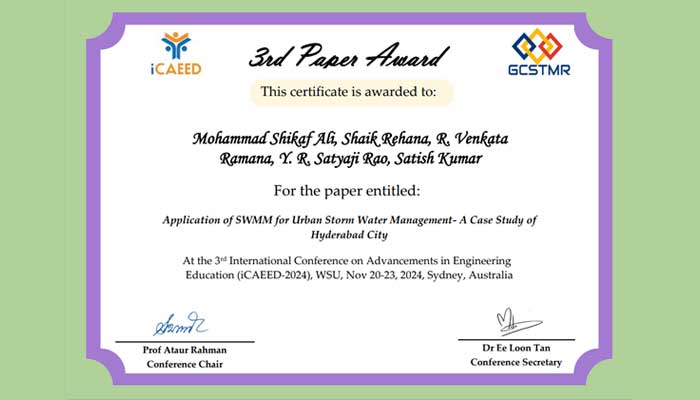Research work on Application of SWMM for Urban Storm Water Management- A Case Study of Hyderabad City by Dr. Shaik Rehana and her Ph.D student Satish Kumar Mummidivarapu was awarded the best paper award at the 3rd International Conference on Advancements in Engineering Education (iCAEED-2024), held in Western Sydney University, Sydney, Australia, from 20 – 23 November.
Dr. Shaik Rehana along with her students M Satish Kumar and Mohammad Shikaf Ali conducted a comprehensive research work focused on Urban storm water management to reduce flood risk and enhance the environmental values and sustainability of urban water systems. The findings of their study were presented by Mummidivarapu Satish Kumar at iCAEED-2024.
Here is the summary of the research work as explained by the authors Mohammad Shikaf Ali S, R Venkata Ramana, Y R Satyaji Rao, Satish Kumar Mummidivarapu, Ataur Rahman and Dr. Shaik Rehana:
Urban stormwater management involves strategies to mitigate the adverse effects of urban runoff. These strategies aim to reduce flood risk and enhance the environmental values and sustainability of urban water systems. But the effective urban stormwater management is highly dependent on the factors such as spatial variability of urban watershed characteristics as well as the scale of the area under consideration. This insight has prompted increasing utilization of physically based urban watershed models such as the Environmental Protection Agency (EPA) Stormwater Management Model (SWMM). Thus, in this study we utilized SWMM for modeling the dynamic runoff response in a stormwater zone of Hyderabad, India. The study results are validated for a particular observed 48-hour storm event occurred on 3rd and 4th of October 2015. Five years (2010-2014) of hourly rainfall data have been used to estimate the design storms with 2, 5, 10, and 25 years return periods using Gumbel distribution. The results indicate that the existing drainage system is insufficient to withstand the generated runoff by the design storm of 2-year return period and causes notable flooding. The water elevation profile generated from the initial node, representing the beginning of the drainage system, to the outfall indicates that the flooding occurred at the outfall during the peak precipitation event. Also, the hydrographs which were developed through SWMM at different links and outfalls are crucial in designing the sumps or ponds and determining pump capacities, aiding in effective stormwater management practices.
December 2024

